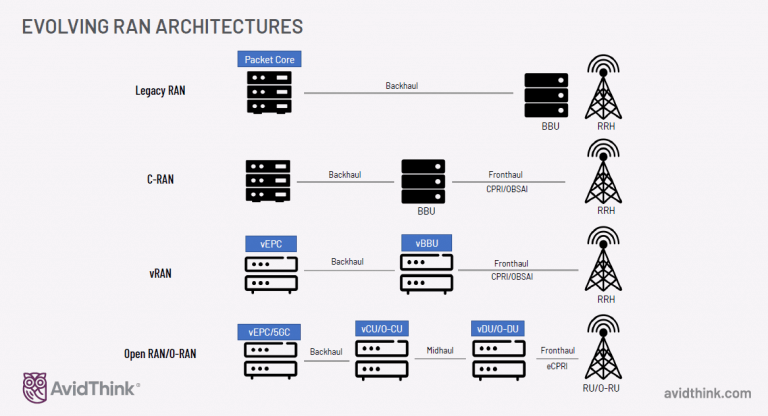Open RAN has gained prominence in the last few years due to ongoing trends towards openness and disaggregation in the mobile network operator (MNO) space and spurred by recent geopolitical pressures. The below explanation is part of Unlocking Open RAN — An Infrastructure Viewpoint white paper.
Evolving RAN Architecture to Open RAN
Over the different generations of wireless technology, the RAN has evolved. 3G networks saw distributed RAN (D-RAN/ DRAN) deployments, with co-located radios (remote radio head – RRH, remote radio unit – RRU) and baseband units (BBU). These BBUs are connected via backhaul networks to the mobile core.

Evolving RAN Architecture
As we progressed into 4G and 4G LTE, RAN deployment architectures evolved into:
Centralized RAN (C-RAN or CRAN) — MNOs centralized BBUs and connected them via fronthaul fiber networks to the RRHs (CPRI or OBSAI protocols). Centralization of BBUs provided opportunities to improve coordination between RRHs in neighboring cells, optimizing spectrum use. Sometimes, C-RAN is also referred to as cloud RAN. However, cloud RAN is also confusingly used to refer to RAN built on cloud-native infrastructure.
Virtualized RAN (vRAN) — Both D-RAN and C-RAN have historically been implemented using vendor-proprietary hardware-based appliances from RAN incumbents like Ericsson, Huawei, and Nokia. The vRAN movement applies NFV principles to the RAN, virtualizing proprietary RAN systems into software running on commercial-off-the-shelf (COTS) hardware — for instance, a virtual BBU (vBBU) on x86 or Arm-based servers. vRAN provides additional flexibility and potentially lowers the cost of the RAN through leveraging commodity hardware.
Open RAN — Refers generically to architectures that have disaggregated components. The RRH + BBU (or vBBU) combination is now split into a centralized unit (CU), a distributed unit (DU), and a radio unit (RU). The DU is connected to the RU via the frontal, and the CU is connected to DU via a mid-haul link. In turn, the CU is connected via a backhaul to the mobile core.
Notes
The CU, DU, RU don’t always have to be separately located, and a single CU can serve multiple DUs, just as a DU can serve multiple RUs.
In Open RAN, the interfaces between the CU, DU, and RU need to be agreed-upon and openly defined, allowing the interchanging of CU, DU, and RU from different vendors.
The functional splits in terms of the work performed by the various components (CU, DU, RU) have to be decided upon in a specific implementation while conforming to the options (split options 1 to 8) as defined by the 3GPP.
Source: https://moniem-tech.com/2021/10/27/evolving-ran-architecture-to-open-ran/


